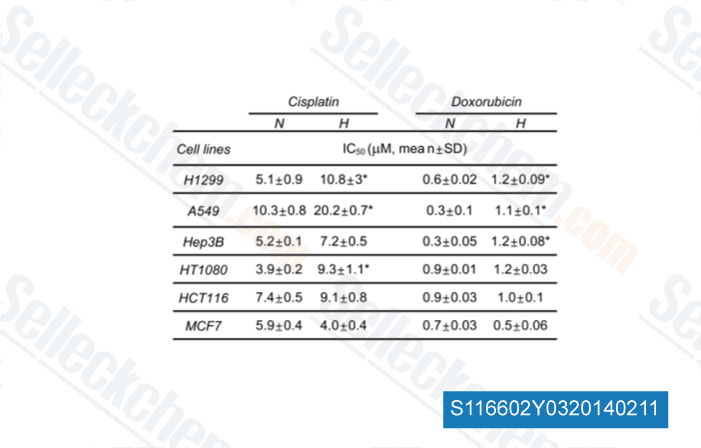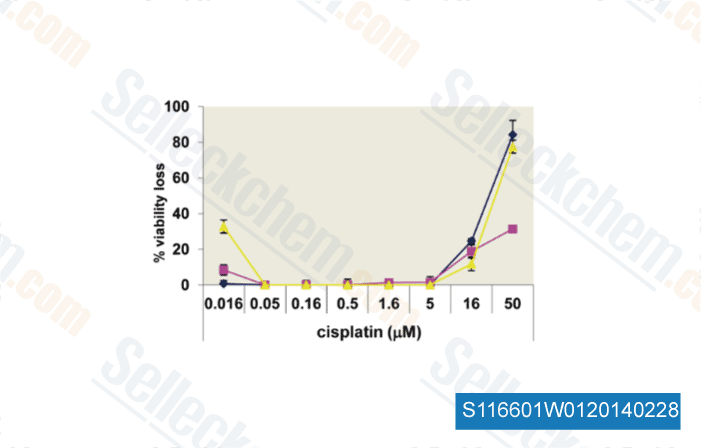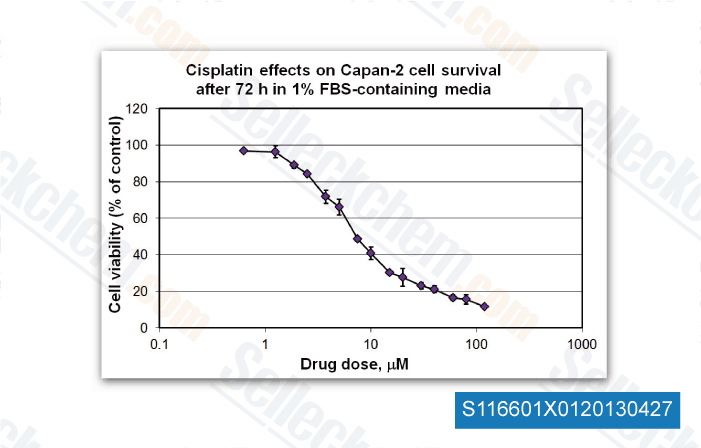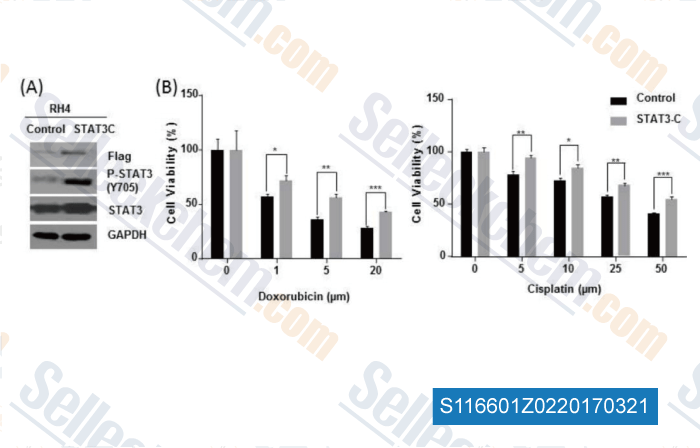|
Toll Free: (877) 796-6397 -- USA and Canada only -- |
Fax: +1-832-582-8590 Orders: +1-832-582-8158 |
Tech Support: +1-832-582-8158 Ext:3 Please provide your Order Number in the email. |
Technical Data
| Formula | Cl2H6N2Pt |
||||||
| Molecular Weight | 300.05 | CAS No. | 15663-27-1 | ||||
| Solubility (25°C)* | In vitro | DMF | 15 mg/mL (49.99 mM) | ||||
| Water | Insoluble | ||||||
| Ethanol | Insoluble | ||||||
| In vivo (Add solvents to the product individually and in order) |
|
||||||
|
* <1 mg/ml means slightly soluble or insoluble. * Please note that Selleck tests the solubility of all compounds in-house, and the actual solubility may differ slightly from published values. This is normal and is due to slight batch-to-batch variations. * Room temperature shipping (Stability testing shows this product can be shipped without any cooling measures.) |
|||||||
Preparing Stock Solutions
Biological Activity
| Description | Cisplatin is an inorganic platinum complex, which is able to inhibit DNA synthesis by conforming DNA adducts in tumor cells. Cisplatin activates ferroptosis and induces autophagy.Solutions are unstable and should be fresh-prepared.DMSO is not recommended to dissolve platinum-based drugs, which can easily lead to drug inactivation. | |
|---|---|---|
| Targets |
|
|
| In vitro | Cisplatin induces cytotoxic by interaction with DNA to form DNA adducts which activate several signal transduction pathways, including Erk, p53, p73, and MAPK, which culminates in the activation of apoptosis. [1] Cisplatin (30 μM) treated for 6 h induces an apparent activation of Erk in HeLa cells, which is sustained over the following 14 h period. Cisplatin also shows an effective antineoplastic activity by inducing tumor cells death[2]. Cisplatin displays ability to cause renal proximal tubular cell (RPTC) apoptosis, causing cell shrinkage, a 50-fold increase in caspase 3 activity, a 4-fold increase in phosphatidylserine externalization, and 5- and 15-fold increases in chromatin condensation and DNA hypoploidy, respectively. [4] Cisplatin (800 μM) causes typical features of necrosis of RPTC after treatment for 4 hr. [5] |
|
| In vivo | Cisplatin has been demonstrated to be efficient in regression tumor growth in a wide variety of animal tumors models, including head and neck cancer xenografts, cervical squamous carcinoma xenografts, testicular carcinoma xenografts, ovarian cancer xenografts, breast carcinoma xenografts, colonic carcinoma, heterotransplanted hepatoblastoma, and so on. Cisplatin (5 mg/kg) given weekly i.v. at the day 1 and 7 induces a tumor growth inhibition (GI) of 77.5% and 85.1% of the serous xenografts Ov.Ri(C) and OVCAR-3, respectively. [6] |
|
| Features | One of the most widely used and most potent chemotherapeutic agents. This product is not recommended to be dissolved in dimethylsulfoxide (DMSO).[7] |
Protocol (from reference)
| Cell Assay: |
|
|---|---|
| Animal Study: |
|
References
|
Customer Product Validation

-
Data from [ Cancer Res , 2014 , 74(1), 298-308 ]

-
Data from [ PLoS One , 2013 , 8(1), e54595 ]

-
, 2013 , Dr. Edita Aksamitiene from Thomas Jefferson University

-
Data from [ , , Curr Cancer Drug Targets, 2016, 16(7):631-8 ]
Selleck's Cisplatin Has Been Cited by 901 Publications
| A single-cell atlas reveals immune heterogeneity in anti-PD-1-treated non-small cell lung cancer [ Cell, 2025, S0092-8674(25)00291-0] | PubMed: 40147443 |
| Cisplatin and temozolomide combinatorial treatment triggers hypermutability and immune surveillance in experimental cancer models [ Cancer Cell, 2025, S1535-6108(25)00223-5] | PubMed: 40513578 |
| A pancreatic cancer organoid biobank links multi-omics signatures to therapeutic response and clinical evaluation of statin combination therapy [ Cell Stem Cell, 2025, S1934-5909(25)00265-6] | PubMed: 40812300 |
| Simvastatin overcomes the pPCK1-pLDHA-SPRINGlac axis-mediated ferroptosis and chemo-immunotherapy resistance in AKT-hyperactivated intrahepatic cholangiocarcinoma [ Cancer Commun (Lond), 2025, 10.1002/cac2.70036] | PubMed: 40443016 |
| SUMO4 promotes SUMO deconjugation required for DNA double-strand-break repair [ Mol Cell, 2025, 85(5):877-893.e9] | PubMed: 40054443 |
| Organoid morphology-guided classification for oral cancer reveals prognosis [ Cell Rep Med, 2025, 6(5):102129] | PubMed: 40359934 |
| A Rac-specific competitive inhibitor of guanine nucleotide binding reduces metastasis in triple-negative breast cancer [ Cell Rep Med, 2025, 6(7):102233] | PubMed: 40633540 |
| TBK1 is a signaling hub in coordinating stress-adaptive mechanisms in head and neck cancer progression [ Autophagy, 2025, 1-23.] | PubMed: 40114316 |
| A novel pathway for stemness propagation and chemoresistance in non-small cell lung cancer via phosphorylated PKM2-loaded small extracellular vesicles [ Theranostics, 2025, 15(8):3439-3461] | PubMed: 40093893 |
| Targeting of the G9a, DNMT1 and UHRF1 epigenetic complex as an effective strategy against pancreatic ductal adenocarcinoma [ J Exp Clin Cancer Res, 2025, 44(1):13] | PubMed: 39810240 |
RETURN POLICY
Selleck Chemical’s Unconditional Return Policy ensures a smooth online shopping experience for our customers. If you are in any way unsatisfied with your purchase, you may return any item(s) within 7 days of receiving it. In the event of product quality issues, either protocol related or product related problems, you may return any item(s) within 365 days from the original purchase date. Please follow the instructions below when returning products.
SHIPPING AND STORAGE
Selleck products are transported at room temperature. If you receive the product at room temperature, please rest assured, the Selleck Quality Inspection Department has conducted experiments to verify that the normal temperature placement of one month will not affect the biological activity of powder products. After collecting, please store the product according to the requirements described in the datasheet. Most Selleck products are stable under the recommended conditions.
NOT FOR HUMAN, VETERINARY DIAGNOSTIC OR THERAPEUTIC USE.
